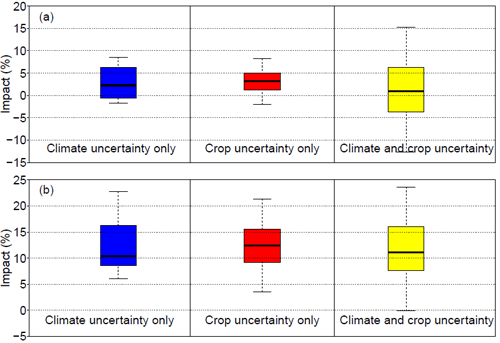Assess Impacts of Climate Change on Crop Yield in Northeastern China
Date:2014-12-22
Northeastern China, comprising the provinces of Heilongjiang, Jilin and Liaoning, is one of the country’s most productive agricultural regions. Against the background of global warming, the climate in NEC is changing dramatically, and thus large fluctuations in crop yield are common. Hence, the projection of future yield responses for this region is crucial for policymakers in taking strategic decisions to guarantee food security and stabilize the provisions market.
Most previous researches applied process-based crop models to evaluate the impact of climate change on crop yields in China and did not consider the uncertainties of climate change on crops. In this study, ZHOU Mengzi and WANG Huijun from Institute of Atmospheric Physics first constructed statistical model for maize (rice) with summer diurnal temperature change (minimum temperature), in which all variables were detrended by adopting the year-to-year increment approach. Then the models included in CMIP5 performing well in simulating present-day climate were selected to project future climate change over NEC. The MME means of summer minimum temperature change in the future showed a distinct increase compared to the baseline time, but yet the evaluated change of diurnal temperature change is not obvious. The expected maize yields caused by aforementioned future climate change increased by 2.92%, 3.11%, and 2.63% for periods 1--3 [2010--39 (period 1), 2040--69 (period 2), and 2070--99 (period 3)] relative to the mean yield in the baseline period (1976--2005), with 95% confidence intervals of (?3.50%, 24%), (?11.74%, 19.60%) and (?5.14%, 13.76%) respectively, when considering the uncertainties of both the climate and the crop models. The rice yield in NEC appeared to benefit more from warming, with percentages of 7.19%, 12.39%, and 14.83%, respectively. Moreover, the uncertainty intervals did not span zero [(1.37%, 14.29%) for period 1, (3.54%, 25.29%) for period 2, and (3.11%, 30.77%) for period 3]. The integration of climate change uncertainty and crop model uncertainty could magnify the total uncertainty, possibly due to the interaction between the two uncertainty sources. Further researches are needed to be done to provide definitive quantification of the potential yield change for policymakers.

Fig. Boxplots of evaluated climate impacts on (a) maize and (b) rice yield after accounting for either climate change only uncertainties (left panel), crop model only uncertainties, or uncertainties from both the climate and the crop model. The boxes extend from the 25th to 75th percentile of projection. The middle horizontal line within each box is the median value. The impacts are expressed as the percentage anomaly of yields in period 2 relative to the baseline (1976--2005) average yields.
Citation: Zhou, M. Z., and H. J. Wang, 2015: Potential impact of future climate change on crop yield in northeastern China. Adv. Atmos. Sci., 32(7), doi: 10.1007/s00376-014-4161-9.
Download: http://159.226.119.58/aas/EN/abstract/abstract2618.shtml
Key words: northeastern China, statistical crop models, climate models, projection, uncertainty
Contact: ZHOU Mengzi (zhoumz@mail.iap.ac.cn)
